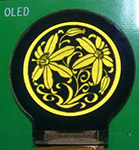It’s Christmas Eve, the perfect time to interact with your extended familial units, eat cookies, nog things up a little, and watch Die Hard. Christmas Eve also means it’s a low-effort day here at Hackaday, so here’s a few cool things we’ve run across in the past few weeks.
A Round OLED Display

That right there is a circular OLED display. [ArtistEngineer] over on reddit found this display on AliBaba. It’s a 1.13 inch diameter display with a resolution of 128×128 (yeah, we don’t know either). This looks like a great display for a DIY wrist watch, digital gauge, or loads of other devices where a square display doesn’t make much sense.
There seems to be a few circular OLED display manufacturers – including Truly Semiconductors who happened to put up a datasheet for their round display – but sourcing these in reasonable quantities is a pain. Anyone up for a group buy? Think of the fun you’ll have coding a polar coordinate display!
Computing with transistors

So you know computers are made up of simple logic gates, latches, buffers, and other miscellaneous digital cruft, but how do we turn these digital circuits into a computer? Over the last few months, [Andrew] has been putting up a bunch of blog posts on the application of digital logic. Start out on the ‘Computing with Transistors’ post before moving on to The Digital State and Circuits and Arithmetic. There’s some good readin’ there.
Embedding 3D objects in a web page
Go ahead. Click it. It’s Sketchfab that allows anyone to publish interactive 3D designs without a browser plugin. If anyone out there is trying to build a Thingiverse clone that isn’t tied to Makerbot, consider using this for the preview page for each object.
Surprisingly, Twinkies were the one thing that didn’t survive the Apocalypse.

While there’s no use in mourning the death of the Twinkie – Little Debbie also makes small cream-filled cakes – you might as well include some Twinkies, Snowballs, Ding Dongs, and Ho-Hos in your Christmas baking. [scoochmaroo] on Instructables put together a list of homebrew recipes for the now defunct Hostess snack cakes.
Perfect for autonomous robots
![]()
[maxogden] over on the gits put together a script for automatically joining wireless networks on Linux. This was tested on a Raspberry Pi, and we’re thinking it would be perfect for whatever autonomous creation you’ll be building in your workshop next year.














I’d definitely be interested in a round OLED display. You can get round LCDs fairly easily and they are used for replacing analogue gauges in cars or on control panels.
DIY low-voltage decatrons?
It sure is interesting. The Truly OLED has quite a chunky margin though and the flat appendage for the chip is quite bulky compared to some of the TFTs I’ve seen.
From the datasheet, it looks like the resolution is 128 pixels across the diameter, but the number of pixels is only 128*128*pi/4. i.e. it behaves like a square display with the corners masked. Minimum order appears to be 100 by the way.
Why not simply place a round shroud over a square one? Either way the issue is coding it to display towards a round output.
I am up for a group buy of a round OLED. might make a good cufflink, like – http://cuffelink.com/2012/12/22/smaller-brighter-better/
There are several tools which use X3DOM to display interactive 3D models on Chrome and Firefox without a plugin. Using X3D is also an option–better performance but requires a plugin. See http://www.web3d.org .
Remember Twinkies are still made in Canada, yea real twinkies, so all you have to do is make a UAV to fly across the border, fly into a 7-11, grab some twinkies and fly back across the border.
I was wondering if those round OLEDs were what the new Furby 2012 used, but no they’re just LCDs.
Would make a terrifying upgrade though, swapping in some red OLED displays for the Furby’s cheapo LCD eyes.
@ autonomous robots:
AutoAP could be more flexible -> http://www.dd-wrt.com/wiki/index.php/Autoap